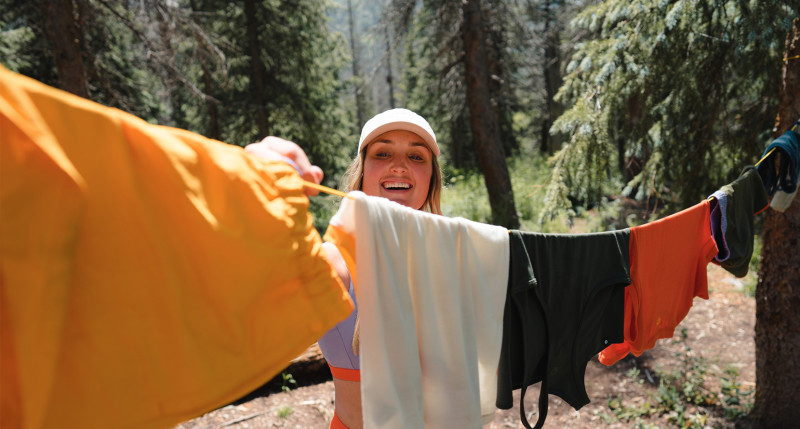
Material guide
You most likely know what cotton, polyester and wool are - but it's always good to know more about the clothes we wear; their characteristics, environmental impact and how to carefor them. This textile guide summarizes information on the most common materials found in outdoor textiles so you can choose the right clothing and care for it so it lasts longer. Good for both you and the environment!
Learn more about different textiles
How do you choose the right clothes and what are good materials for clothes? Of course, it depends on when you intend to use the garment and for what purpose. Different textiles have different properties depending on what they are made of and how they are made. In this guide, we have chosen to divide textiles according to what they are made of: Natural fiber and Artificial fibers. Within Natural fiber there are textiles made from animal fibers and plant fibers – within Artificial fibers there are regenate fiber and synthetic fibers. At the end of this guide is a conclusion of some advice on how to care for your clothes in a way that is less harmful for the environment.
What to consider when choosing material
- Think about what properties you want a material to have for the activity you will use them for
- There is no perfect material – you have to decide for yourself what is most important to you when it comes to sustainability and your personal needs
- Clothes last longer when you take good care of them, be sure to follow the washing instructions
- Airing is enough to refresh most materials – you will save energy, water and wear less on the garment
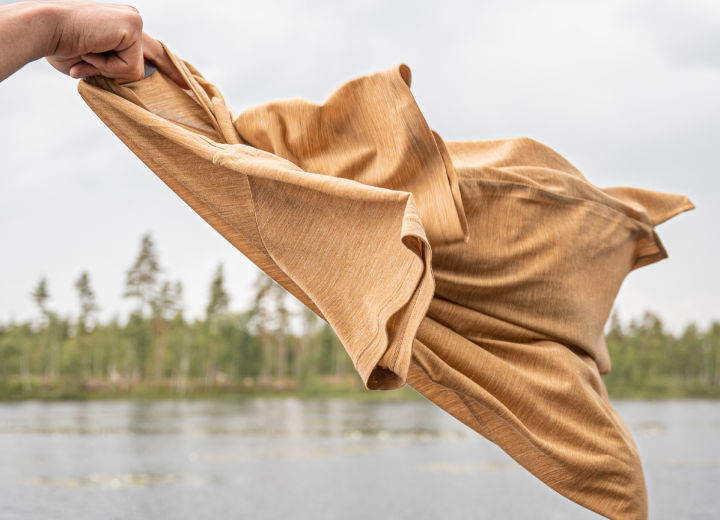
Natural fiber
Natural fibers are textile fibers produced from plant or animal fibers and are generally more environmentally friendly than artificial fibers – natural fibers are, for example, biodegradable. Animal fibers are textile fibers from animals which consist mostly of protein fibers and include both hair fibers from mammals and silk fibers from silkworms. Plant fibers, on the other hand, are fibers made up of cellulose and are extracted from the seed, fruit, stem and bast of various plants.
Animal fiber
Animal fiber has different properties and even fiber from the same animal species can differ. Here we take a closer look at some commonly occurring animal materials.
Wool
Wool is a textile fiber that is produced from the fur of various mammals and is used to make the textile wool. Depending on which animal the wool comes from, it is called different things, some different types of wool are for example cashmere which is considered the finest, merino which is also thinner than sheep's wool and mohair from the angora goat. Wool has antibacterial properties, which means that it does not need to be washed too often. Wool traps air which makes it heat regulating, this means that wool will both keep you warm when it's cold and cool when it's hot. In addition, wool has the ability to absorb water without feeling wet or impairing its warmth. Therefore, wool is a good material to wear on the skin, as a base layer and underwear, for example.
Wool is a renewable raw material sinec the sheep can be sheared many times and not be damaged by it. At Outnorth we have decided not to sell products with wool from animals exposed to mulesing. Mulesing means scalping the behind of sheep to prevent insect infestations, but it hurts the sheep which is why we don't want this done to animals. We also do not sell products that contain angora wool.
As aforementioned, you don't need to wash wool very often, a tip is to try hanging your wool garments out before you wash them – that's usually enough to refresh them. When you wash woolen garments, it is important to wash them cooler than 30 °C, otherwise you risk the garments shrinking. It is also important to use a mild detergent that is suitable for washing wool. Detergents with lanolin can improve your woolen garment by strengthening its water resistancy, heat regulation and antibacterial ability. Wool should not be tumble-dried, it dries best on a flat surface, you can gently pull the garment a little when it is wet to help it regain its shape.
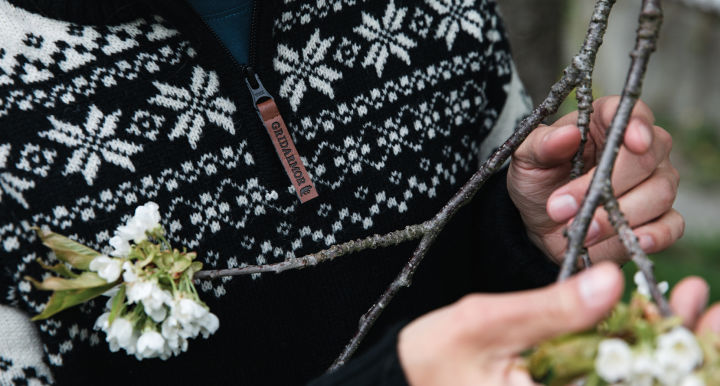
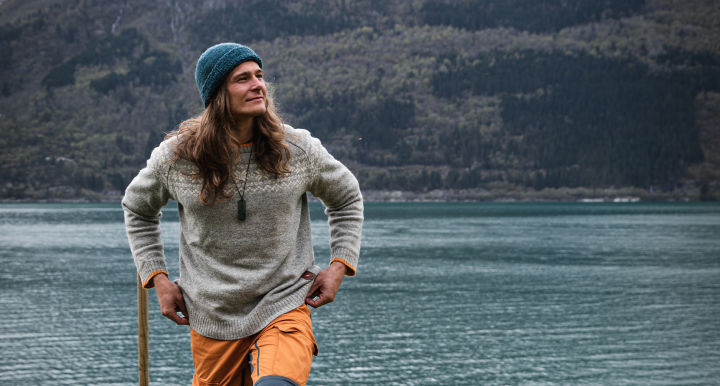
Down
Down is an inner layer of finer feathers on birds that is often used as heat-insulated padding in outdoor clothing such as down jackets and equipment like sleeping bags. It is thanks to the down's ability to encapsulate air that it provides warmth, but most products with down filling also contain feathers. Therefore, the proportion of down and feathers in a product is often given either as a percentage (for example 80 % down, 20 % feathers) or as two numbers separated by a slash (for example 80/20) where the first usually represents the down. Down products often have a value called Fill Power, which is measured in cuin and indicates the fluffiness of the down filling. The Fill Power value does not tell you how warm a product is but rather the quality of the down. Fill Power measures how many cubic inches of fluff an ounce of the down filling provides. A little tricky - we know, but you can remember that a higher Fill Power, like 900 cuin, is beneficial if you want a light and thin down jacket, while if you're less concernde about weight or thickness, a 500 cuin jacket is just as good . 500-650 cuin Fill Power is good enough for most weather conditions while 700-900 cuin is recommended for the lightest possible weight or very cold climates.
At Outnorth, we work with sustainability in all parts of the company and have decided to only sell down from animals in the food industry. This is because down production where the whole animal is used results in a more sustainable consumption of the down. In addition, we also do not sell down from animals that have been plucked alive, this to minimize the suffering of the animals.
It is important to take care of your down products, for example, should you need to wash your down jacket, it is important to first read the label in the jacket and follow the instructions. The easiest thing, however, is to wash away stains with a sponge or cloth to save nature's resources, your time and extend the life of your garment. But if the whole jacket really needs to be washed, either hand washing is recommended, which can be done in a bucket, tub or bathtub with a mild detergent. Or you can wash the jacket in the washing machine at a maximum of 40 °C with a mild detergent. The drying process is important for the down to retain its fluffiness. Drying the down jacket in the dryer with a few tennis balls has long been recommended, but at Outnorth we know that the down and feathers can then break, which makes it sharp and can lead to it startint to push through the lining and outer material and stick out of the jacket. You can dry the down jacket in the dryer, but dry it on a low temperature for approx. 6 h and take it out every two hours and massage the down to restore the fluffiness. An alternative to making the down jacket fluffy and dry is to hang it in a warm, dry and well-ventilated room and let the jacket and down dry naturally. In that case, however, it is required that you go and shake the jacket several times (approximately 2 times per hour) in order for the down to be distributed evenly and to dry properly.
Down jackets
Silk
Silk is cocoon threads from the cocoons of various caterpillars that are spun into silk fabric. Silk is appreciated for its absorbency, which means that it is a suitable textile for intensive activities and warm weather. In your outdoor clothing, silk can be found in, among other things, socks and in equipment such as sleeping bag lining. Silk fiber is a soft textile fiber that is included in several different textiles such as silk and chiffon, which have a smooth surface and feel light to the touch.
To produce silk thread, the cocoons are placed in warm water so that it can be wound up, the pupae die in this process. However, wild linen can be a friendlier alternative as it is sometimes made from cocoons left by the larvae and therefore does not cause harm.
To wash textiles with silk in them, it is important to look at the washing instructions in the product. In general, silk is washed at a maximum of 30 °C, either by hand or in a gentle program in the washing machine. After washing, silk should be drip dried, silk dries quickly so putting it in the dryer is unnecessary.
Leather
Leather is a durable and versatile material made from animal hides that have been treated to preserve them well. Thanks to its malleability, leather is a very useful material that is widely used in outdoor equipment and clothing. Leather is windproof which makes it an excellent material for shoes, gloves and bags for example. It also becomes water-resistant if you clean, lubricate and – above all – wax the leather.
Leather has a long life if it is cared for properly, which means you can use your leather products for a long time. However, the production of leather produces some environmental emissions. The biggest causes of emissions in leather production are cattle breeding, which emits a lot of carbon dioxide, as well as the use of chemicals in the tanning process. At Outnorth we have decided not to sell leather from exotic animals such as crocodiles, snakes and sharks, or domesticated animals such as cats and dogs. In addition, we only sell lether from animals in the food industry.
It is important to clean and lubricate your leather products to extend their life. Leather is best cleaned with a small amount of water and leather soap on a cloth, rub the leather and wipe with a dry cloth. Next, the leather must be greased with leather grease of some kind, you can also make your own with beeswax and canola oil that you melt together. It is important that the leather does not get too wet, then it will dry out. Applying too much grease, on the other hand, will open the pores too much which can damage the seams. Everything in moderation then, and it's a good idea to use leather wax after the grease has sunk in to protect the leather against water and dirt.
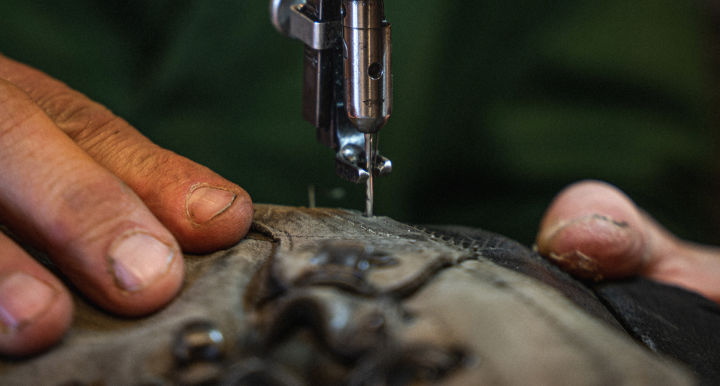
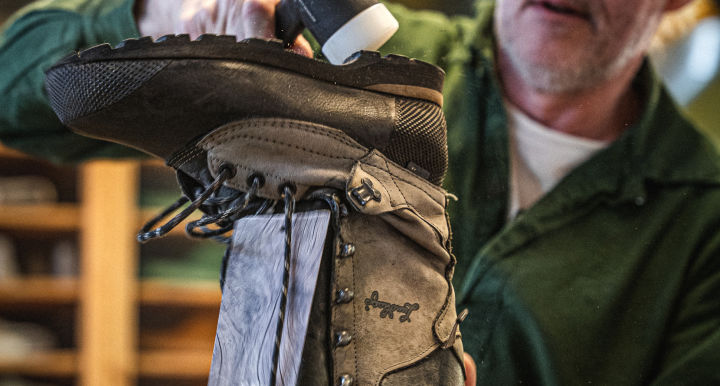
Leather products
Plant fiber
Plant fibers also have different properties depending on the plant they come from. Unlike regnate fiber, plant fiber can often be harvested several times a year, therefore plant fiber is sometimes more environmentally friendly and cheaper.
Cotton
Cotton is the most common fiber in textiles due to its low price and good properties. Cotton is strong and thermally conductive, which means that it conducts heat away from the body, which is well suited for training- and everyday clothes.
As cotton is a natural product, it is environmentally friendly in itself. However, a lot of water and pesticides against insects is required during cultivation, which can cause environmental harm.
Wash your cotton garments at 30-60 °C, and consider washing at lower temperatures if the garments are not heavily soiled. Then you save energy, money and your clothes!
Hemp
Hemp fibers come from the cannabis plant and have a long history of uses in outdoor and sports equipment. Canvas or sail cloth was originally made from hemp fibers, for example. Today, hemp is making its way back into the market due to its durability. Hemp textiles are similar to linen textiles as it has a slightly coarser texture and is therefore stronger than cotton. Like wool, hemp is antibacterial and counteracts bad odors, and hemp dries quickly.
Hemp fibers are completely biodegradable which makes them sustainable. Hemp does not need pesticides or fertilizers and produces a large yield per hectare, which makes it a more environmentally friendly alternative than, for example, cotton. The plant roots also bind the soil and prevent soil erosion. From an environmental perspective, hemp is therefore a very good choice, with good properties for durable clothing.
Hemp does not risk being destroyed by washing but becomes softer after each wash. It is recommended to wash hemp at 30 °C preferably in a laundry bag with a gentle spin to avoid wrinkles. Detergents with optical bleach are not recommended. You can pull the garment into shape after washing and then hang or lay it flat to dry. The same applies here as with wool, however, try airing the garment before washing it to save nature's resources as hemp is naturally antibacterial.
Linen
Linen textiles are made from plant fibers from flax. Linen is a textile that mostly appears in home textiles but can also be found in outdoor textiles. In terms of properties, linen is a strong and long-lasting material thanks to the long textile fibers. Linen absorbs water well and dries quickly, making it a comfortable fabric to wear in warm climates.
The manufacturing process for linen is long, but it does not require a lot of pesticides as it often grows in colder climates. Linen is therefore a more sustainable alternative than cotton and synthetic materials. However, the linen is waterrotted, which causes oxygen-consuming substances to leak into the water. In addition, herbicides are used in most of the plantations.
Linen can be washed at up to 60 °C, but often a colder temperature such as 30–40 °C is sufficient. But even linen can be aired to refresh it, and stains can be removed with a sponge and water. To dry linen, tumble drying at a lower temperature or hanging the garment to dry is recommended.

Artificial fibers
Artificial fiber is fiber that is manufactured artificially. Regenate fiber is produced from natural products where the molecules are converted into a solution which is then re-formed (regenerated) into a textile form. Synthetic fiber is instead made from synthetic organic polymers.
Regenate fiber
The regenate fibers discussed here all belong to the cellulose group, but there are also cellulose acetate fibers which are less common. Regenat fibers have different properties depending on the natural product used and the manufacturing process.
Lyocell
Lyocell, or Tencel which is a popular trade name, is made from fir or other trees. Lyocell is similar to many other common textiles such as cotton and linen but is more absorbent than cotton. In addition, lyocell has good moisture-transporting properties, which makes the textile feel soft and airy. Lyocell is good for everyday- and training clothes due to its properties.
The chemicals used in the production of lyocell are used in a closed system, which makes the manufacturing process more environmentally friendly than other artificial fibers that release some environmentally hazardous substances. In addition, the solvent used for lyocell is gentle on the environment. Sometimes bamboo is also used as a raw material, which is beneficial from a sustainability perspective as bamboo grows quickly, needs less water and needs no pesticides.
Lyocell is washable and can be washed at 30-40 °C and then hung to dry. You can also remove stains with a sponge and air the garment instead of washing it.
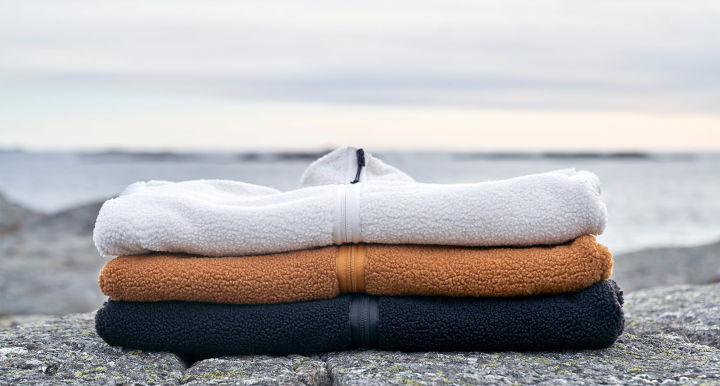
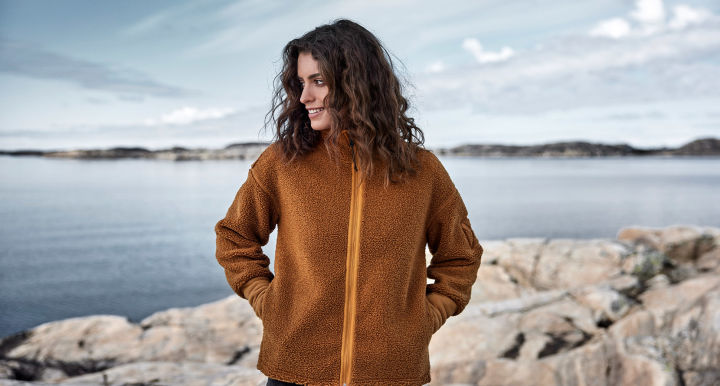
Modal
Modal is a soft and elastic textile that is often used in underwear, training clothes, bedding and towels. Modal is made from beech trees which do not require much water to grow, therefore modal is a more sustainable alternative to cotton. Something that distinguishes modal from, for example, viscose, is that it is strong even when wet and that the textile does not lose its shape.
Modal is a biodegradable textile and is considered more environmentally friendly than cotton because the production process of modal uses 10-20 times less water than cotton. The textile is made from regenerated cellulose from beech trees, but the process can, on the other hand, cause emissions that affect the environment.
Modal can be washed at any temperature, but a colder temperature such as 30 °C is usually enough. Then hang dry or tumble dry at a lower temperature. Take out and hang the garment when it is still damp to avoid wrinkles.
Viscose
Viscose is a light and breathable textile that is often used in training clothes and t-shirts. In addition, viscose is absorbent and soft, it looks like silk but feels like cotton.
Viscose is made from cellulose from various trees and the chemicals used during the manufacturing process cause environmental impacts if released. A lot of water can be used to grow trees in viscose production, therefore bamboo is an alternative raw material that is sometimes used today. Bamboo grows quickly, needs less water and no pesticides – on the other hand, large amounts of chemicals are often used which have a negative impact on animals, nature and people.
When washing your viscose clothes, it is important to remember that viscose can lose its shape or shrink. Therefore, we recommend washing viscose by hand or in a washing cycle with a shorter spin at a maximum of 30 °C. Like wool, it is good to carefully lay the garment flat in a well-ventilated room for drying. This is because viscose loses its strength when it is wet and strong centrifugation, careless handling such as wringing the garment or drying it too hot can ruin your garment.
Training clothes
Synthetic fibers
Synthetic fibers resemble plastics as they are made from synthetic organic polymers, often petroleum. As synthetic fibers are strong and elastic, they are well suited for use in training clothes, for example. On the other hand, synthetic fibers have poorer absorbency, which means that they easily form static electricity.
Acrylic
Acrylic fibers are durable fibers produced from polyacrylonitrile or polyacrylic. Thanks to its light weight, warming and soft properties, acrylic is used in, for example, socks, caps, gloves and mid layers. Acrylic can also imitate other materials depending on the use of the fibers – it can imitate cotton and is also made into imitation fur.
During the production of acrylic solvents and chemicals are required, which have a large environmental impact if they are released. In addition, acrylic can release microplastics which can leak into nature when the material is washed and then cause environmental damage.
As acrylic is dimensionally stable, acrylic garments can be washed in the washing machine at 40 °C. Tumble drying is not recommended because it can result in the garment losing its elasticity and shape. Wash the garment in a laundry bag that filters out most microplastics and remember to wash acrylic garments infrequently to protect the environment.
Elastane
Elastane fiber is a polyurethane fiber that is characterized by being very elastic. Often, elastane is only used in a smaller proportion in garments made from other fibers such as cotton or polyester. Thanks to its quick-drying and elastic properties, elastane is often used in training clothes, swimwear, underwear and socks. The feeling of elastane against the skin is soft and allows you to move without restriction.
Just like acrylic fiber, the production process of elastane also requires solvents and chemicals that can have a negative environmental impact. In addition, when washed, elastane can release microplastics into the water, which negatively affect aquatic organisms.
When you wash garments with elastane, it is wise to consult the washing instructions on the label in the garment, as elastane is often mixed with other textile fibers that may need to be washed in a certain way. In general, however, elastane should be washed in cold water, 30 °C is recommended so as not to destroy the elasticity of the material – fabric softener should also be avoided for the same reason. Hanging to dry elastane garments is also beneficial as elastane is heat sensitive and should not be tumbledried.
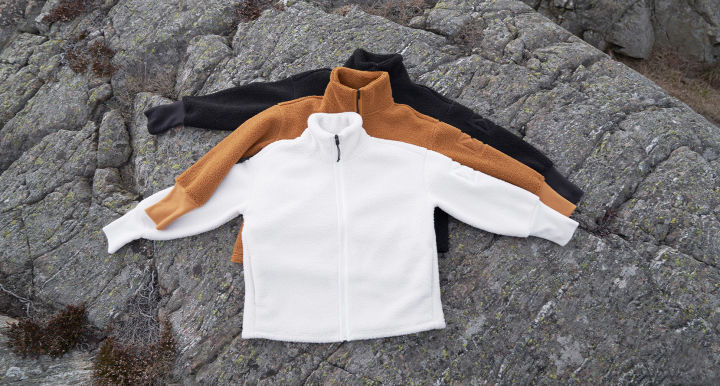
Polyamide
Polyamide, or nylon as it is also known as, is a group of synthetic fibers that are similar in appearance and feel to silk. Polyamide is characterized by its elasticity and wear resistance; moreover, polyamide rarely wrinkle. Polyamide has many uses and is found in everything from parachutes and ropes to fishing nets and clothing. In outdoor textiles, polyamide is found in everything from underwear and base layers to your outermost layers.
Polyamide, like all synthetic fibers, is plastic-like, and the production of these fibers requires chemicals that can harm both animals and nature. In addition, polyamide can give off small plastic particles that can also damage aquatic organisms, but this can be countered by using a specially adapted laundry bag that filters out some of the microplastics.
Polyamide is often mixed with other textiles and therefore it may be wise to read the washing instructions on the label inside the garment. In general, polyamide withstands up to 40 °C and holds its shape well without shrinking. As polyamide dries quickly, it is recommended not to tumble dry to avoid unnecessary wear and tear.
Polyester
Polyester is the most common synthetic fiber and one of the most common textile fibers in clothing in general. As a durable, elastic, wrinkle-free and moisture-wicking textile fiber, it is no wonder that polyester has become popular. Polyester is found in most garments from underwear to winter jackets.
Polyester requires environmentally hazardous chemicals in its production and can give off microplastics in the washing machine, just like other synthetic fibers. On the positive side, however, polyester can be made from recycled plastic, which is becoming increasingly common among outdoor textiles.
Polyester can be washed at a maximum of 40 °C to avoid the risk of the garment shrinking in the washing machine. Since polyester dries quickly and is sensitive to heat, tumble drying is not recommended, instead let the garment dry by hanging.
Synthetic base layers
Polypropylene
Polypropylene (polypropylene or PP) is a textile fiber that is heat-retaining and moisture-wicking. Therefore, polypropylene is often used in base layers and socks, but also in training clothes. Polypropylene is also common in packaging and toys.
Polypropylene is a synthetic fiber and is made from propylene, a manufacturing process that requires chemicals that can be hazardous to the environment if released. In addition, polypropylene can release microplastics into the washing machine, which can harm animals and the nature.
As polypropylene is often mixed with other textile fibers, it is important to read the washing instructions on the garment before washing it. Washing at a lower temperature saves energy and wears less on the clothes. In addition, washing polypropylene garments in a laundry bag that catches microplastics is a good idea to prevent these from leaking into nature.
Polyurethane
Polyurethane (PU) is used to make elastane but can also be used as a soft plastic coating over other textiles. The coating makes the material waterproof but still soft and comfortable. Some polyurethane coatings also have breathability and are then called membranes, if you want to read more about membranes and their care, we recommend our membrane guide. Polyurethane is mainly used on rain clothing, shell clothing and gloves that are waterproof.
Polyurethane is used as an alternative to PVC coatings that often contain phthalates to make the coating softer – therefore the already soft PU coating is a better choice. In addition, certain coatings are placed on the inside of the outer fabric and then an impregnation is added on the outside. These impregnations may contain fluorocarbons (PFAS or PFCs) which can be dangerous both for nature and for people.
To make your polyurethane coated clothes last longer, it is best to avoid washing them, instead it is better to take a cloth and wipe the garment or rinse it in the sink. If the garment really needs to be washed, it is recommended to do it inside out in a gentle program with a mild detergent without fabric softener. The PU coating cannot be restored if it has been damaged, so it is important to take good care of it.
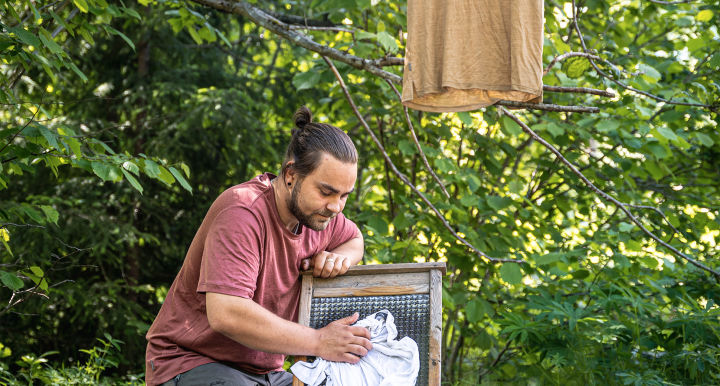
Sustainability advice
The textile industry is a major climate culprit, and it is not easy to choose the most environmentally friendly material since all textiles have their pros and cons. Ultimately, the choice is yours and subjective opinions often come into play; maybe you want to stay away from animal products, alternatively you consider microplastics to be the biggest threat to nature. Whatever you choose, we want you to feel satisfied and comfortable in your clothes. But how can you minimize your clothes environmental impact?
- Wash only when needed – instead of washing clothes in the washing machine, you can use a cloth or sponge to remove stains. You can also air garments that need to be refreshed – hang the garment out in the garden, on the balcony or just in an open window. Remember that darker clothes should not be aired in direct sunlight, then the color can fade. When you do wash them, remember to fill the machine properly, wash in cool temperatures and avoid fabric softeners. This will not only save nature's recourse but also extend the life time of your clothes. There are also laundry bags that capture microplastics, what the bag collects you can then throw in the trash or remove with your vaccum cleaner.
- Don't throw away clothes – try to give away or sell clothes that you no longer use. Giving away clothes to friends and family is one option, donating to charity is another. Today it is also easy to sell your clothes second hand.
- Buy smart – remember to only buy things that you need, then you save nature's resources and spare your wallet. It may also be worth thinking about the quality of the products you buy, it is better to choose an item that will last a long time, than one you need to replace after a couple of uses.
Which fabric is the best?
To return to the question we asked at the beginning – what is the best material for clothing? It is subjective and depends entirely on what you are going to do and how you approach care and sustainability. There is no one superior material, all textiles have different properties are more or less suitable for different activities. This guide has hopefully given you the information you need to answer your questions about different materials so you can choose what you want to wear and how best to care for your textiles.